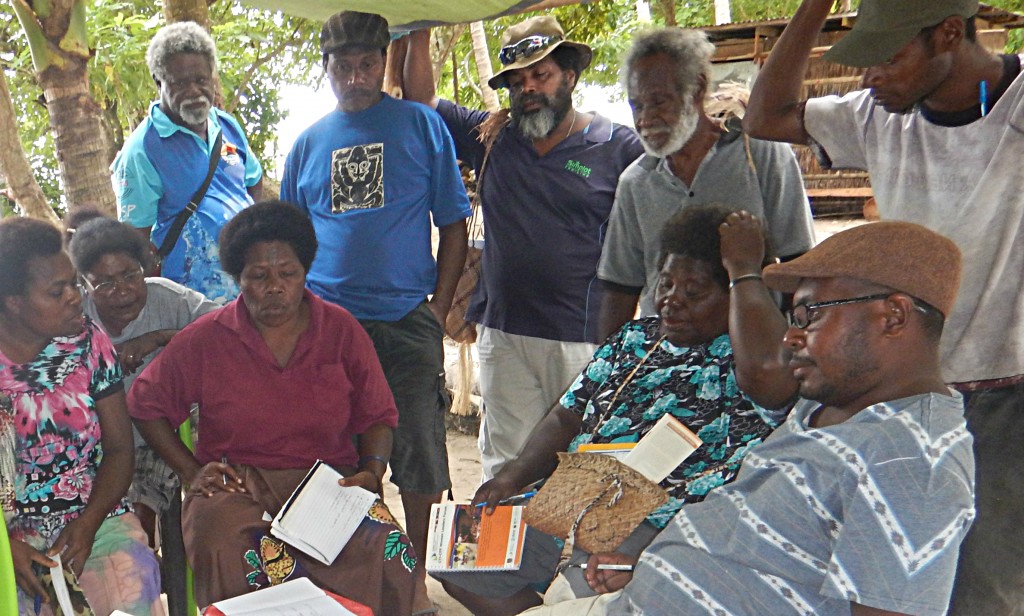Local Early Action Planning & Management Tool
The Local Early Action Planning and Management (LEAP) Tool was developed in 2010 through a collaborative process with community members, resource managers, conservation practitioners, and representatives from various sectors (e.g., food security, fisheries, disaster risk management, climate science) in Micronesia. ref The tool was designed to be used by conservation practitioners and partners to help communities in Micronesia implement adaptation planning with a focus on ecosystem-based actions. The LEAP tool helps community practitioners facilitate participatory activities to improve community understanding of climate change impacts, engage stakeholders and sectors in the planning process, and facilitate an understanding of which climate and non-climate threats to social and ecological resources are most important. ref In 2012, the U.S. Coral Triangle Initiative Support Team adopted and adapted the tool for the Coral Triangle to support climate change adaptation in the region.
The tool includes four steps:
- Getting the community/project team organized for climate awareness and adaptation planning
- Understanding climate change and the local climate story
- Conducting a threat and vulnerability assessment
- Developing a LEAP or Management Plan
Each step includes instructions for community facilitators, worksheets/templates with guiding questions, and exercises to be conducted with community members and/or a core resource management planning team. Most exercises are based on participatory rural appraisal methods used in natural resource management (e.g., seasonal calendar, historical timeline, and community mapping) and users are encouraged to build on materials developed through previous management planning processes rather than create new products. ref Application of the LEAP requires community facilitation expertise, basic knowledge of climate change science, climate impacts, and adaptation strategies across multiple sectors.

Fishers work to identify community climate adaptation implementation options for Ahus Island, Papua New Guinea. Photo © TNC
Advantages of the LEAP Tool
- ease of use
- local relevance in Micronesia (and coastal and island communities in tropical developing countries more broadly)
- focus on community health and well-being
- can be a standalone planning tool or information gathered can be incorporated into existing plans
- allows for key messages on climate change science to be communicated simply using illustrations
- utilizes participatory processes that allow community members to understand vulnerability to climate change through their own experiences in combination with climate science
- focuses on community social and ecological health, instead of a single sector, allowing for an integrated approach that takes both natural and human resources into consideration
Limitations of the LEAP Tool
- participatory processes take considerable time to implement
- not geared toward urban settings or communities with complex social/governance structures
- does not deal with gender dimensions of vulnerability to climate and environmental changes and adaptation
- details on how to implement adaptation actions and achieve “SMART” objectives are not provided
- adaptation strategies identified through LEAP may require technical skills and capacities that communities do not possess (e.g., dealing with coastal erosion and inundation)
Lessons Learned
- programs and projects addressing climate change adaptation need to emphasize capacity development of community facilitators in their long-term plans and funding
- ideally, funding for adaptation actions should be in place before planning is initiated to kick-start early action plans
- it is important to manage community expectations that some actions may be implemented immediately, while others may require longer time frames and additional funding to be implemented
- communities that have gone through the process of a LEAP and have identified priority adaptation actions are often well positioned to apply for and receive climate adaptation funding
- the LEAP tool was developed with a strong focus on natural resource management planning, so local teams may need technical expertise from other sectors (water, disaster risk reduction, agriculture) to identify and evaluate adaptation options
- building relationships with key staff members from multiple agencies and sectors early in the LEAP process is critical to achieve buy-in for planning and implementation, access to new information, and ongoing technical support
Based on the need for additional technical support, a number of new tools have been developed to support community adaptation to climate change such as a guide on understanding and planning for coastal change issues (i.e., coastal erosion and flooding, a guide on designing effective locally managed marine areas, guidance for the Coral Triangle on ecosystem-based management and developing fisheries management plans using an ecosystem-based approach to address both human and ecological well-being).
